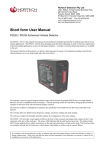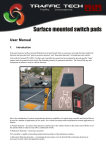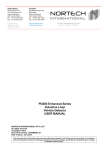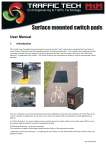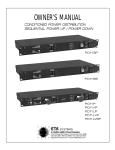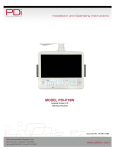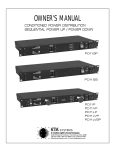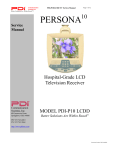Download Short form User Manual
Transcript
Nortech Detection Pty Ltd Unit1, Bldg 5, Forest Central Business Park, 49 Frenchs Forest Road, Frenchs Forest NSW 2086 PO Box 6011, Frenchs Forest DC, NSW 2086 Tel: 02 8977 4047 Fax: 02 9475 4742 email: [email protected] web: www.nortechdetection.com.au Short form User Manual PD132 / PD134 Enhanced Vehicle Detector The PD130 is a single channel microprocessor based detector designed specifically for parking and vehicle access control application. The PD130 has been designed using the most up-to-date technology in order to meet the requirements of a vast number of parking applications in terms of operating conditions and options available to the user. The primary function of the detector is to detect vehicle presence by means of an inductance change caused by the vehicle passing over a wire loop buried under the road surface. The detector has been designed for ease of installation and convenience. The various modes are selected by changing the positions of the switch on the front of the unit. The switches allow for different loop frequency settings, sensitivity settings and mode settings. The PD130 provides visual output (LED) on the front of the enclosure and relay changeover contacts are taken on the 11-pin connector at the rear of the enclosure. The LED indicates the power has been applied to the unit, that a vehicle is present over the loop and if there is a fault on the loop. The Presence relay is fail-safe and will close on a vehicle detect or in the event of power failure. In accordance with the manufacturer’s policy of updating and improving product designs, product specification is subject to change without notice. While every care has been taken with the preparation of this document, no warranty is offered to the completeness or accuracy of this information. PD132 / PD134 Enhanced Vehicle Detector - User Instructions Page 2 of 9 1. Operating Instructions 1.1. Switch Setting Selections 1.1.1. Frequency Switch The frequency switches are the lower two switches, numbered 1 and 2. There are four frequency selections and are set out as follows: SW2 Off SW1 Off - High On Off - Medium-High Off On - Medium-Low On On - Low The frequency switches allow the loop to be shifted higher or lower depending on the switch position. The frequency of the loop is determined by the loop size, and the frequency of the switch simply causes a frequency shift on the loop. Where more than one detector is used the detectors must be set-up to ensure that there is no cross-talk (interference) between the detectors. This can be achieved by ensuring that the loops of the two detectors are spaced sufficiently apart (approximately 2 metres between adjacent edges) and also ensuring that the detectors are set to different frequencies. As a general rule, the detector connected to the inductive loop with the greatest inductance should be set to operate at the lowest frequency. Loop inductance increases as loop size, number of turns in the loop and feeder length increases. 1.1.2. Sensitivity The sensitivity of the detector allows the detector to be selective as to the change of inductance necessary to produce an output. There are four sensitivity selections and these are set as follows: SW4 Off SW3 Off - High On Off - Medium-High Off On - Medium-Low On On - Low PD132 / PD134 Enhanced Vehicle Detector - User Instructions Page 3 of 9 1.1.3. Automatic Sensitivity Boost Automatic sensitivity boost is a mode that alters the “undetect” level of the detector. This mode is selected by switch No. 5 on the front of the enclosure and is as follows: SW5 Off On - Disabled - Enabled Automatic sensitivity boost causes the sensitivity to be boosted to a maximum on detection of a vehicle, and maintained at this level during the presence of the entire vehicle over the loop. When the vehicle departs the loop and the detection is lost the sensitivity reverts to the pre-selected level. 1.1.4. Filter Mode The filter mode is selected with the mode switch No. 6. The filter produces a delay turn-on time of two seconds when a vehicle is occupies the loop. This is to enable small, unwanted objects to pass over the loop without being detected. The filter option may be used on any sensitivity setting and is selected as follows: SW6 Off On - Disabled - Enabled 1.1.5. Pulse Relay The pulse relay may be made to operate on detect (entry) or on “undetect” (exit) of a vehicle. This option is selected from Switch No. 7 and is configured as follows: SW7 Off On - Pulse on Detect - Pulse on Undetect 1.1.6. Presence Time The presence time may be set to permanent presence or to limited presence. In permanent presence mode the detector will continuously compensate for all environmental changes whilst there is a vehicle present over the loop. The presence mode is set with switch No. 8 and is configured as follows: SW8 Off On - Limited Presence - Permanent Presence 1.1.7. Reset Switch The detector automatically tunes to the inductive loop connected to it when the power is applied, whether on initial installation or after any break in power supply. Should it be necessary to re-tune the detector, as may be required after changing any of the switches or after moving the detector from one installation to another, momentary operation of the RESET switch will initiate the automatic tuning cycle. PD132 / PD134 Enhanced Vehicle Detector - User Instructions Page 4 of 9 1.2. Front Panel Indicator While the detector is tuning, the ON (Red) LED will glow and the OUTPUT LED (Green) will extinguish when the system is tuned. Thereafter, the green LED will flash at a rate of 1 Hz. This is used to indicate the frequency of the loop to the user. Every flash of the LED is equivalent to 10 kHz. It will stop when the operating frequency is reached. This operation is also performed whenever the reset button is depressed. The ON (red) LED will glow permanently to indicate that the unit is functional. The red LED also serves as an optical interface to the DU100 Diagnostic Unit. If faults exist with the loop the green LED will come on and flash off at the rate of 2Hz indicating the fault. If the fault is self-healing the detector will continue to operate but the LED will remain on indicating to the user that a fault has occurred. The LED will go off for a moment during an “undetect”, indicating this state, thereafter returning on. This condition can be restored by removing the power or by depressing the reset button. The green LED will also glow whenever a vehicle is detected passing over the inductive loop. 1.3. Detector Tuning Tuning of the detector is fully automatic. When power is applied to the detector upon installation of the system, or when a reset is initiated, the detector will automatically tune itself to the loop to which it is connected. The detector will tune to any loop to inductance range 20 to 1500 microhenries. This wide range ensures that all loop sizes and feeder combinations will be accommodated in the tuning range of the detector. Once tuned, any slow environmental change in loop inductance is fed to a compensating circuit within the detector that keeps the detector correctly tuned. 1.4. Detector Sensitivity Sensitivity of the detection system is dependent on factors such as loop size, number of turns in the loop, feeder length and the presence of metal reinforcing beneath the loop. The nature of the application determines the required sensitivity that may be adjusted by means of the sensitivity switches on the front of the enclosure. Sensitivity levels of the PD130 have been carefully optimised for parking and vehicle access control applications. The detection of small unwanted objects such as bicycles and trolleys can be eliminated by selecting lower sensitivity levels whilst high-bed vehicles and vehicle/trailer combinations will not loose detection by using automatic sensitivity boost (ASB) option. ASB operates as follows. When ASB is disabled the undetect level is dependent on the sensitivity setting of the detector. Hence as the detector is made less sensitive, the undetect level will reduce accordingly. When the ASB is enabled the undetect level will always be the same irrespective of the sensitivity setting and will be equivalent to the undetect level when the sensitivity is on maximum setting. 2. Modes of Operation In the presence mode the detector will give a continuous output during the presence of a vehicle over the inductive loop. As the detector is designed with the permanent presence feature, the detector will indicate vehicle presence for an unlimited period of time. If the permanent presence is not selected, then the detect time will be dependent on the change of inductance. The presence time on the limited presence setting will be approximately 1 hour for 3% ∆ L/L PD132 / PD134 Enhanced Vehicle Detector - User Instructions Page 5 of 9 The pulse relay outputs a pulse of 150 milliseconds duration. When set to “pulse on detect” the detector will give a pulse on detection of a vehicle and when set to “pulse on undetect” the detector will give a pulse output when the vehicle leaves the loop. The presence output is known as a fail-safe output. This implies that in the event of a power failure the detector will give a detect output. The pulse outputs are not fail safe and will not operate if a failure occurs. 3. Technical Specification Self-tuning range 20 to 1500µH Sensitivity Four step switch selectable: High 0.02% Δ L/L Medium High 0.05% Δ L/L Medium Low 0.10% Δ L/L Low 0.50% Δ L/L Filter Switch selectable 2 Second filter Presence Relay Fail-safe Pulse Relay Switch selectable: Pulse on detect Pulse on undetect Pulse Output Duration 150 milliseconds Response Times 100 milliseconds Drift Compensation Rate Approx. 1% Δ L/L per minute Relay Rating 5A @ 230VAC Surge protection Loop isolation transformer, gas discharge tubes, and Zener diode clamping on loop input Power requirements 12 - 24V AC/DC (PD134) 230V AC ±10 % ( 48 to 62Hz ) Requirement: 1.5 VA Maximum @ 230V Operating Temperature -40°C to +70°C Mounting Position Shelf or DIN rail mounting Connections 11-pin submagnal type (JEDEC No. B11-88) Size of Housing 78mm (H) X 41mm (W) X 80mm (D) PD132 / PD134 Enhanced Vehicle Detector - User Instructions Page 6 of 9 4. Wiring Connections 11-pin connector wiring pin 1 2 3 4 5 6 7 8 9 10 11 5. colour designation Red Black Grey Violet Yellow Brown Blue Blue Green Pink White Live Neutral Pulse Relay Pulse Relay Presence Relay Presence Relay Loop Loop Earth Presence Relay Pulse Relay 230V AC 50/60 Hz OR 12 - 24V AC/DC Normally Open contact Common contact Normally Open contact Common contact Twist this pair Normally Closed contact Normally Closed contact Part Numbers Part Number 301FT0101_01 Model Number PD132 - Enhanced Description 230 V ac operation 301FT0122_01 PD134 - Standard 12 - 24V ac/dc operation 895FT 0001 DU100 - English Hand Held Diagnostic Unit 301FT0041 Option - 1 metre plug and harness CTR119090 DIN Rail Screw terminal base PD132 / PD134 Enhanced Vehicle Detector - User Instructions Page 7 of 9 6. Installation Guide Optimum functioning of the detector module is largely dependent on factors associated with the inductive sensor loop connected to it. These factors include choice of material, loop configuration and correct installation practice. A successful inductive loop vehicle detection system can be achieved bearing the following constraints in mind, and strictly following the installation instructions. The detector must be installed in a convenient weatherproof location as close as possible to the loop. 6.1. Operational Constraints 6.1.1. Crosstalk When two loop configurations are in close proximity, the magnetic fields of one can overlap and disturb the field of the other. This phenomenon, known as crosstalk, can cause false detects and detector lock-up. Crosstalk between adjacent loops operating from different detector modules can be eliminated by: 1. Careful choice of operating frequency. The closer together the two loops, the further apart the frequencies of operation must be. 2. Separation between adjacent loops. Where possible a minimum spacing of 2 metres between loops should be adhered to. 3. Careful screening of feeder cables if they are routed together with other electric cables. The screen must be earthed at the detector end only. 6.1.2. Reinforcing The existence of reinforced steel below the road surface has the effect of reducing the inductance, and therefore the sensitivity, of the loop detection system. Hence, where reinforcing exists 2 turns should be added to the normal loop, as referred to in section 5.3. The ideal minimum spacing between the loop and the cable and steel reinforcing is 150mm, although this is not always practically possible. The slot depth should be kept as shallow as possible, taking care that the feeder remains exposed after the sealing compound has been applied. WARNING : Cutting into post tensioned concrete slabs can have catastrophic consequences. As a general rule 30mm is the deepest slot depth allowable in such cases. When any doubt exists the structural engineer’s approval must be sought prior to commencement. 6.2. Loop and Feeder Specification The loop and feeder should preferably constitute a single unjoined length of insulated copper conductor, with a minimum rating 15Amp. Joints in the loop or feeder are not recommended. Where this is not possible, joints are to be soldered and terminated in a waterproof junction box. This is extremely important for reliable detector performance. 6.3. Sensing Loop Geometry Sensing loops should, unless site conditions prohibit, be rectangular in shape and should normally be installed with the longest sides at right angle to the direction of traffic movement. These sides should ideally be 1 metre apart. PD132 / PD134 Enhanced Vehicle Detector - User Instructions Page 8 of 9 The length of the loop will be determined by the width of the roadway to be monitored. The loop should reach to within 300mm of each edge of the roadway. In general, loops having a circumference measurement in excess of 10 metres should be installed using two turns of wire, while loops of less than 10 metres in circumference, should have three turns or more. Loops having a circumference measurement less than 6 metre should have four turns. It is good practice at time of installation to construct adjacent loops with alternate three and four turn windings. 7. Loop Installation All permanent loop installations should be installed in the roadway by cutting slots with a masonry cutting disc or similar devise. A 45° crosscut should be made across the loop corners to reduce the chance of damage that can be caused to the loop at right angle corners. NOMINAL SLOT WIDTH: 45mm NOMINAL SLOT DEPTH : 30mm TO 50mm A slot must also be cut from the loop circumference at one corner of the loop to the roadway edge to accommodate the feeder. A continuous loop and feeder is obtained by leaving a tail long enough o reach the detector before inserting the cable into the loop slot. Once the required number of turns of wire is wound into the slot around the loop circumference, the wire is routed again via the feeder slot to the roadway edge. A similar length is allowed to reach the detector and these two free ends are twisted together to ensure they remain in close proximity to one another (minimum 20 turns per metre). Maximum recommended feeder length is 100 metres. It should be noted that the loop sensitivity decreases as the feeder length increases, so ideally the feeder cable should be kept as short as possible. The loops are sealed using “quick-set” black epoxy compound or hot bitumen mastic to blend with the roadway surface. Figure 1 Slot details PD132 / PD134 Enhanced Vehicle Detector - User Instructions Page 9 of 9 Figure 2 Adjacent loops connected to different detector modules










